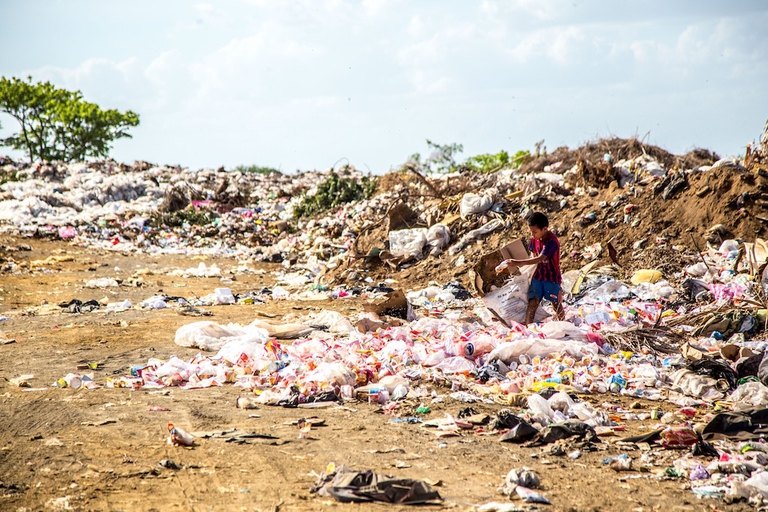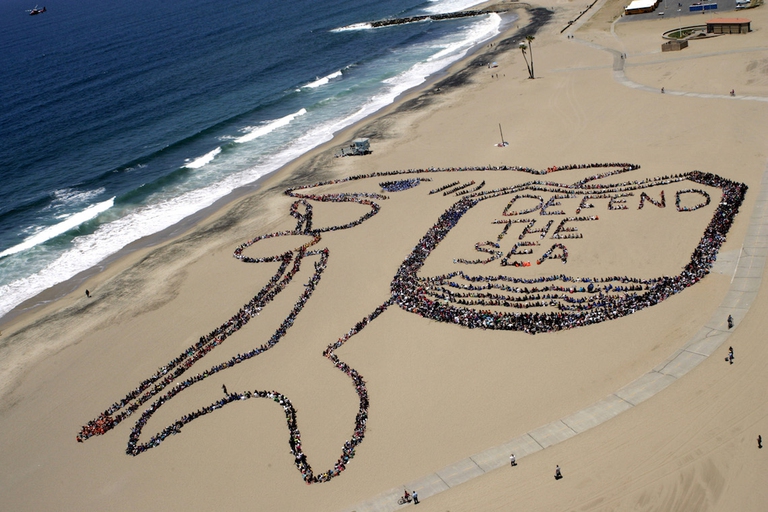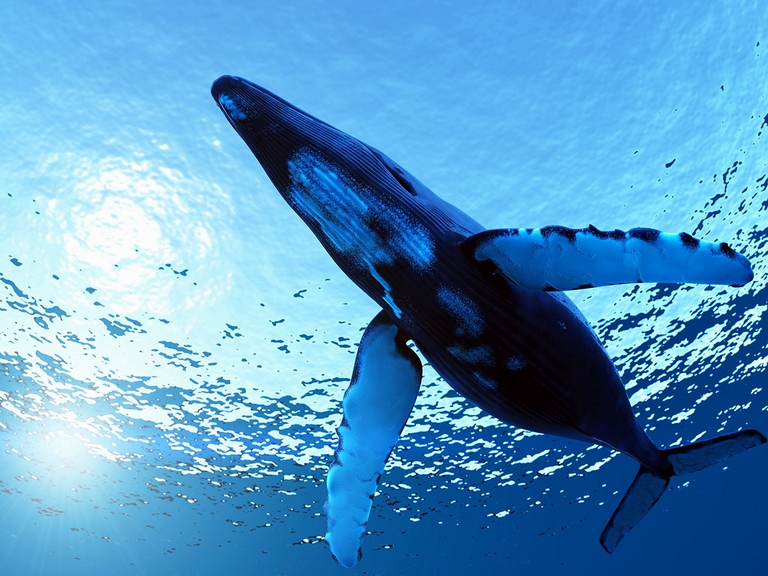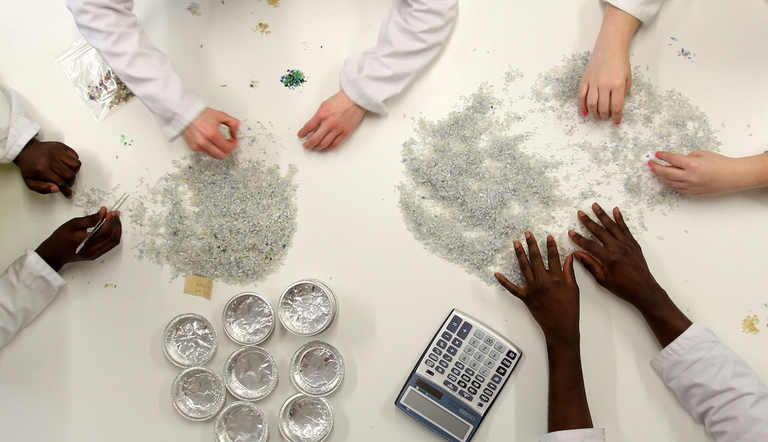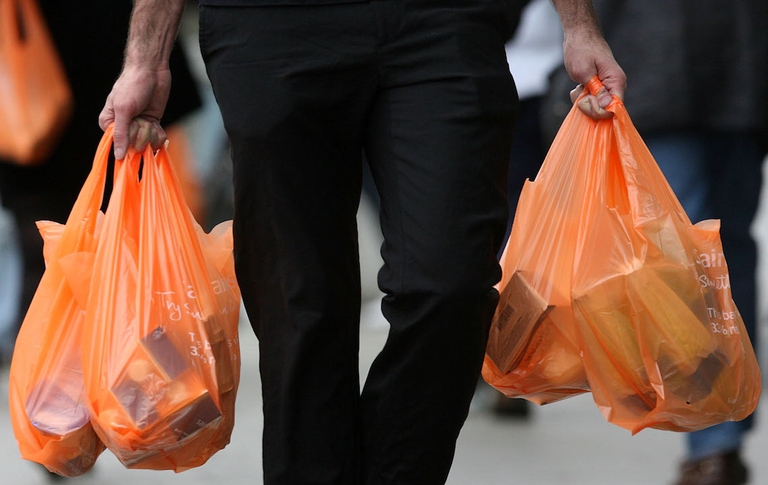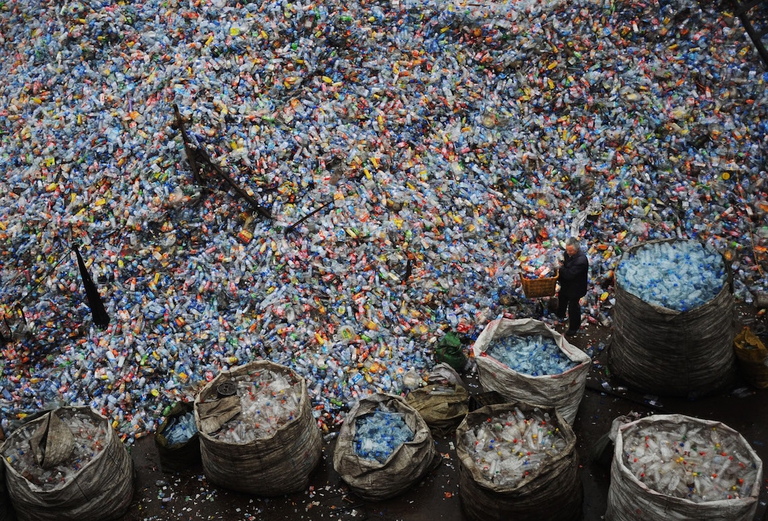
Sharon Lavigne, one of the six winners of the 2021 Goldman Environmental Prize, is fighting to protect her community from plastics corporations.
Microplastics are choking our oceans and threatening our health. A guide to the key facts on what microplastics are, where they come from and what is being done to eliminate them.
Various scientific studies have shown that microplastics are hazardous to human health and the environment, especially marine and aquatic habitats. This occurs because plastic melts in the span of a few years and as long as it remains submerged in water, it can be swallowed and accumulated in the body and tissues of multiple organisms.
Read more: Plastic particles found in drinking water across the world
Microplastics are small plastic particles that pollute our seas and oceans. Their name is given by their small size, as their diameter measures between 330 micrometres and 5 millimetres.
Even smaller particles called nanoplastics exist but sampling them is impossible with the technology currently available, due to their size. Therefore, we still know very little about them. Here we explain the sources and effects of microplastics, as well as the actions being taken, in an attempt to give an idea of the magnitude of the pollution they cause, and how governments and international organisations are tackling it.
Read more: Pete Ceglinski. Even a single Seabin can turn the tide on plastic pollution
Let’s start from the where microplastics come from: these fragments are “crumbs” of larger polymers, so-called primary plastics. When plastic ends up in water, it dissolves into smaller fragments. This is caused by many factors, for example ultraviolet rays, wind, waves, microbes and elevated temperatures.
Since many elements contribute to the deterioration of plastic in the ocean, it’s hard to say exactly how much it takes for a polymer to dissolve into microplastics. The fragmentation process is also prolonged by chemicals used during manufacturing to give materials different characteristics, such as antimicrobial plastics or flame retardants that make them more resistant to UV rays as well as waterproofing treatments.
Read more: How ocean warming will kill fish, make them smaller and potentially toxic
Global plastic production went from 1.5 million tonnes to more than 280 million tonnes from the 1930s to the first decade of the 2000s (with a 38 per cent growth in the last ten years). The consequences are obvious: as more plastic is used, more is thrown into the sea, directly or indirectly. Up to 12.7 million tonnes every year, according to Greenpeace.
Various shapes and forms of plastic are present in marine environments: bags, microbeads, packaging, construction coating, polystyrene containers, tape and fishing equipment. Nevertheless, research shows that approximately 80 per cent of all plastic debris present in the environment comes from dry land.
“Water depuration systems can trap plastic and fragments of various sizes through oxidation tanks or sewage sludge,” Rosalba Giungi, president of the Marevivo association, committed to defending marine environments, explains. “Nevertheless, a large portion of microplastics manage to pass through this filtration system and reach seas and oceans after being thrown into rivers”.
Read more: Croatia is a clean sea champion thanks to microorganisms
Once these substances reach the sea, they’re ingested by fauna (especially plankton, invertebrates, fish, seagulls, sharks, whales and dolphins) and can alter the food chain. According to the environmental research institution ISPRA, 15 to 20 per cent of marine species that end up on our tables contain microplastics, whilst according to researchers from the National University of Ireland, who fished mesopelagic species that live from 200 to 1000 metres deep in the North Sea, this concentration reaches 73 per cent.
Plastic swallowed by fish, shellfish and crustaceans also ends up on our tables. So the effects are also felt by humans: the pollutants released by microplastics can be ingested and absorbed by us. These can interfere with the human endocrine system and produce genetic modifications.
Most worrying are elevated concentrations of chemicals such as persistent organic pollutants (POPs) – which include polychlorinated biphenyl (PCB) and Dichlorodiphenyltrichloroethane (DDT) – whose names are determined by their toxicity and resistance to decomposition. According to the data gathered by International Pellet Watch, large quantities of PCB were detected on the northern coast of France, in the Channel, and significant traces of DDT were found on the coast of Albania. This shows that even though most plastic is concentrated in other areas of the sea, pollutants are still transported everywhere, even entering partially closed marine areas.
Read more: Ocean Array Cleanup, the first revolutionary system that removes ocean plastic is ready to set sail
According to the latest United Nations Environment Programme (UNEP) report, every square kilometre of the ocean contains on average 63,520 microplastic particles, with significant variations on a regional level. For example, the levels in Southeast Asia are 27 times higher compared to othes. The Mediterranean is one of the most polluted seas in the world: 7 per cent of all the microplastics in the world are found here. Furthermore, there are five oceanic regions (called gyres) where currents funnel the largest amount of debris.
The UNEP includes the issue of plastic waste present in our oceans and seas in the list of the six most pressing environmental issues globally. If we don’t do something now, there will be more plastic than fish in our seas by 2050.
Read more: The world’s oceans will be home to more plastic than fish by 2050
During the 1990s, cosmetics and make-up manufacturers started to use “microbeads” in skin detergents, toothpastes and shaving foams. In the second half of the 2000s, investigations have found these plastic microspheres in public water systems and in nature, ultimately ending up in the water that runs from our taps.
The fibres in synthetic materials contain large amounts of microplastics that then end up in wastewater and aquatic environments. The use of synthetic fibres has largely increased in the fashion industry – satisfying almost 61 per cent of the global demand for fibres.
Plastic fibres like polystyrene, acrylic and polyamide are “eroded” when washed and drained into waterways. The Norwegian Environment Agency calculated that every time a single piece of clothing is washed it releases up to 1,900 synthetic fibres. The same source tells us that this is also why microplastic emissions from washing clothes are higher than those from cosmetics, and constitute 35 per cent of all microplastics present in water.
Read more: Timberland turns recycled plastic bottles into shoes and bags
The external part of a tyre is made from synthetic polymers mixed with rubber and other additives. According to research carried out by the IUCN, a large number of microplastics is created by the friction of tyres on asphalt. The plastic fibres released are then carried into marine environments by wind or rain. The research also explains that road signs (made with thermoplastic), release small particles under certain weather conditions.
Ships still cause very large amounts of marine waste: even though an international agreement that forbids fishing boats from abandoning fishing nets and plastic entered into force in 1988, the amount of plastic left at sea was around 6.5 million tonnes at the start of the 1990s.
Fighting marine pollution is one of the Sustainable Development Goals (SDGs) set by the United Nations in 2015, number 14 to be exact. Meanwhile, various laws have been introduced in different countries in order to tackle this problem.
Former president Barack Obama signed the Microbead-Free Waters Act 2015, banning the use of small plastic beads in rinse-off cosmetics like toothpastes and skin lotions. This law was an inspiration for many other countries to follow suit, even though it doesn’t include other cosmetic products such as make-up. There are various other local laws adopted by cities or states. For example, San Francisco will ban plastic bottles starting from 2020.
Read more: San Francisco thinks outside the bottle to reach its goal of zero waste by 2020
In the Old Continent, the United Kingdom has adopted the same ban on microplastics in all cosmetic products. Furthermore, Queen Elisabeth II declared her desire to forbid the use of disposable plastic in all royal estates, replacing it with biodegradable plastic. In addition, the UK-based supermarket chain Iceland has decided to phase out all plastic packaging by 2023, and use plant-based or cardboard alternatives. English supermarkets produce 800,000 tonnes of packaging waste every year.
Italy produces 60 per cent of the world’s cosmetics, and according to MP Ermete Relacci a law that will ban microplastics is being drawn up, even though it has been stalled by the Senate for the last two years. Various environmental organisations, including Marevivo, Legambiente, Greenpeace, Lav, Lipu, MedSharks and WWF have subscribed to an appeal presented to the Senate demanding the application of this law starting from 2020. Meanwhile, the country has banned non-biodegradable cotton swabs and has recently introduced the use of biodegradable plastic bags in all commercial activities.
Ireland was one of the first countries to move in this direction, as early as 2002, implementing a tax on every bag that was sold (which is currently more than 20 Euro cents). The same measure was adopted in Wales, Belgium and Denmark. In England this regulation applies to companies with more than 250 employees. During the plenary meeting held on the 16th of January at the European Parliament in Strasburg, the European Commission presented the strategy to reduce marine litter. Every year Europeans generate 25 million tonnes of plastic waste but less than 30 per cent is recycled. Plastic represents 85 per cent of the waste found on beaches around the world. The objective is to make all plastic waste in Europe recyclable by 2030, also increasing reuse – which is currently only 30 per cent of the total – and reduce the use of microplastics.
Rosalba Giungi, president of Marevivo, which just launched a campaign for the substitution of straws with biodegradable materials, stated: “We welcome this strategy with open arms but we have to replace disposable plastic, like cutlery made from petroleum, that ends up in landfills or incinerators”. The European document includes dispositions regarding waste produced by ships and measures aimed at reducing costs for ports, ships and authorities, “but a law is urgently needed to properly dispose of waste once fishermen bring it to shore, in order to reduce its dispersion at sea”. According to the UE, the plan could create 200,000 new green jobs.
Read more: Stella McCartney and Parley for the Oceans team up to clean the seas from plastic
China is the largest recycler of plastic in the world but it shut imports of plastic waste to concentrate on what is being produced locally. After president Xi Jinping announced he was going to block the importation of 24 materials in July 2017, his next move was to block imports of plastic, paper, tissues and some metals, with the objective of bringing domestic recycling to 350 million tonnes by 2020.
Read more: Costa Rica aims to become the first country to ban single-use plastics
Many African countries have outlawed plastic bags: South Africa, Eritrea, Rwanda and recently Kenya. The production of disposable plastic was banned about one year ago in India, starting from New Delhi, where the problem of plastic manufacturing fuels illegal fires.
Siamo anche su WhatsApp. Segui il canale ufficiale LifeGate per restare aggiornata, aggiornato sulle ultime notizie e sulle nostre attività.
![]()
Quest'opera è distribuita con Licenza Creative Commons Attribuzione - Non commerciale - Non opere derivate 4.0 Internazionale.
Sharon Lavigne, one of the six winners of the 2021 Goldman Environmental Prize, is fighting to protect her community from plastics corporations.
Plastic pollution is airborne too. Microplastics are being carried across continents by the wind, as a recent study reveals.
A group of experts in Tokyo suggested pouring radioactive water from Fukushima into the open sea. A marine biochemist explains the consequences of this absurd decision.
Levels of particulates in New Delhi in 2020 were once again far above safety thresholds, with extremely serious health consequences for its citizens.
The decline in grey and humpback whales in the Pacific and Atlantic Oceans has been traced to food shortages caused by rising ocean temperatures.
The United Nations has launched a major international alliance for ocean science, undertaking a mission close to all our hearts.
A major oil spill in the Ecuadorian Amazon in April has left the Coca River polluted. The indigenous Kichwa are suing the companies whose pipelines broke.
Molecules that eat up plastic waste, including PET bottles, may soon become widely used as scientists leap ahead in developing new super enzymes.
In Italy’s Land of Fires between Naples and Caserta, activists like Carmen Medaglia are fighting to promote new ways of managing waste.
